You can recycle your stainless steel water bottle, supporting sustainability by conserving resources and reducing waste. This action aids in promoting a greener future and minimizing environmental impact. Remember to clean the bottle, remove labels, and follow local recycling guidelines. Beyond recycling, there are creative ways to repurpose old bottles and tips to maintain their longevity. By recycling your stainless steel water bottle, you play a part in creating a healthier environment for future generations.
Benefits of Recycling Stainless Steel Water Bottles
Recycling stainless steel water bottles contributes to reducing waste and conserving valuable resources in a sustainable manner. By opting for reusable alternatives like stainless steel water bottles, you're embracing eco-friendly options that promote a sustainable lifestyle and aid in reducing waste.
These bottles are durable, long-lasting, and can be recycled multiple times without losing their integrity, making them an excellent choice for environmentally conscious individuals.
Choosing stainless steel water bottles over single-use plastic ones not only minimizes the amount of waste ending up in landfills but also helps in conserving energy and reducing carbon emissions associated with manufacturing new bottles. Embracing this eco-friendly alternative is a simple yet effective way to make a positive impact on the environment.
Additionally, by adopting sustainable practices like recycling stainless steel water bottles, you're actively contributing to the preservation of natural resources for future generations. Make a conscious choice today to reduce waste and promote sustainability through small yet impactful actions.
Understanding the Recycling Process
To comprehend the recycling process for stainless steel water bottles, understanding the various stages involved and the significance of each step is essential. Here are some key points to help you grasp the process more effectively:
- Collection: The first step involves collecting used stainless steel water bottles from recycling bins or designated collection centers.
- Sorting: Once collected, the bottles are sorted based on their material composition to ensure that only stainless steel bottles are processed further.
- Melting and Purification: The sorted bottles are then melted down to remove impurities and contaminants, resulting in high-quality stainless steel material.
- Reforming: The purified stainless steel is then reformed into new products like water bottles, reducing the need for raw materials and energy-intensive manufacturing processes.
Understanding the recycling process not only conserves resources but also reduces waste and energy consumption. By actively participating in recycling initiatives, you contribute to a more sustainable environment, debunking misconceptions about the complexity of recycling stainless steel products.
Environmental Impact of Recycling
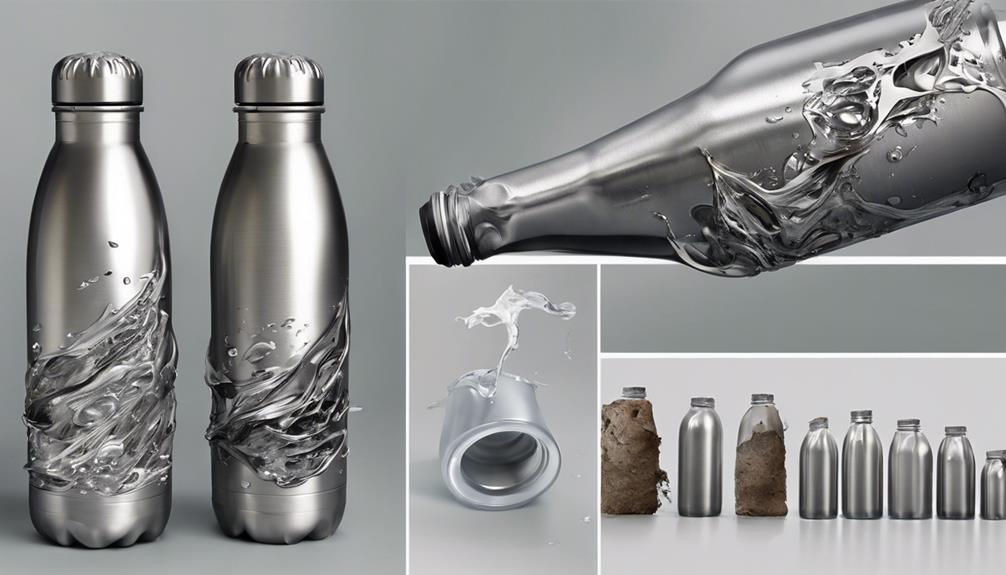
Understanding the environmental impact of recycling stainless steel water bottles involves evaluating the energy savings, resource conservation, and emissions reduction associated with the process. Recycling benefits include reducing the need for raw materials, lowering energy consumption, and decreasing greenhouse gas emissions. By recycling stainless steel water bottles, you contribute to sustainable practices that help preserve natural resources and reduce environmental harm.
| Environmental Impact Metrics | Description | Benefits |
|---|---|---|
| Energy Savings | Recycling stainless steel requires less energy than producing new materials. | Reduces overall energy consumption. |
| Resource Conservation | Recycling conserves valuable resources like iron ore and coal used in steel production. | Decreases the need for raw materials. |
| Emissions Reduction | Recycling stainless steel emits fewer greenhouse gases compared to manufacturing from scratch. | Helps mitigate climate change. |
Embracing sustainable practices through recycling not only minimizes waste but also fosters a more environmentally conscious society. By recognizing the positive environmental impacts of recycling stainless steel water bottles, you actively contribute to a greener and more sustainable future.
Steps to Prepare Your Bottle for Recycling
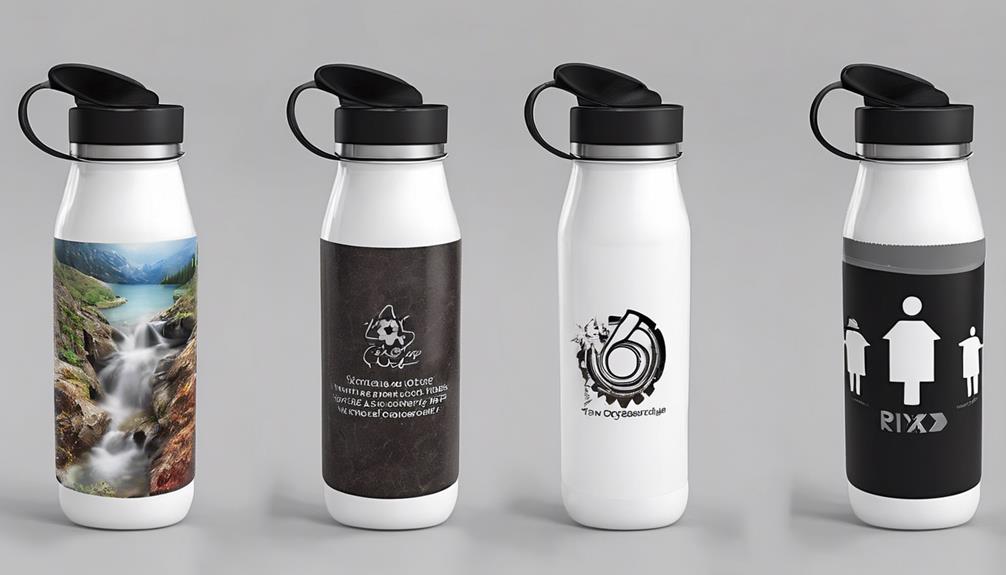
Properly cleaning and removing any labels from your stainless steel water bottle is an essential first step in preparing it for recycling. To ensure your bottle is ready for recycling, follow these steps:
- Cleaning tips:
Wash your stainless steel water bottle with warm, soapy water and rinse it thoroughly. Avoid using harsh chemicals that could contaminate recycling facilities.
- Label removal:
Peel off any paper or plastic labels from your bottle. These materials can be disposed of properly in the trash to prevent contamination during the recycling process.
- Proper disposal:
If your bottle has any silicone or rubber parts, remove them before recycling. These components can often be recycled separately or disposed of properly to prevent contamination.
- Recycling facilities:
Check with your local recycling center to understand their specific requirements for recycling stainless steel items. Some facilities may have different guidelines or collection methods.
Common Misconceptions About Recycling
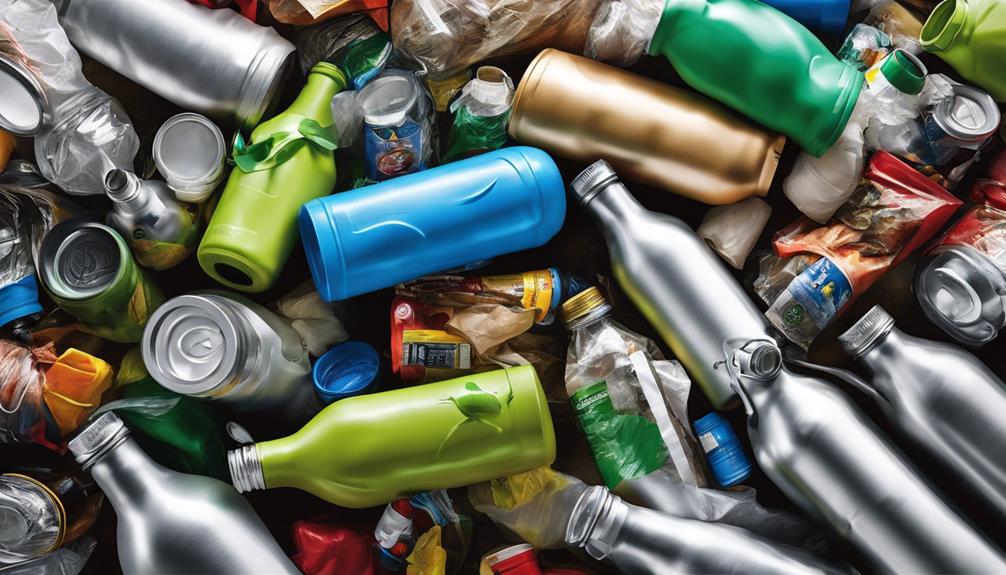
You might've heard various myths surrounding the recycling of stainless steel water bottles.
It's crucial to separate fact from fiction when it comes to the environmental impact of recycling these bottles.
Understanding the common misconceptions can help you make more informed decisions about recycling practices.
Recycling Stainless Steel
Many individuals mistakenly believe that recycling stainless steel water bottles is a complicated process, but in reality, it's quite straightforward. Stainless steel is a highly recyclable material with numerous benefits for the environment. Here are some key points to consider:
- Recycling benefits: Recycling stainless steel reduces the need for raw materials, leading to energy conservation and lower greenhouse gas emissions.
- Sustainable alternatives: Opting for stainless steel water bottles over single-use plastic ones contributes to reducing plastic waste in landfills and oceans.
- Durability: Stainless steel bottles have a long lifespan, making them a sustainable choice for daily use.
- Recycling process: Stainless steel can be recycled infinitely without losing its quality, showcasing its sustainability and eco-friendliness.
Incorporating stainless steel water bottles into your daily routine not only benefits the environment but also promotes a more sustainable lifestyle. Make the simple choice to recycle and reuse stainless steel products for a greener future.
Myths and Facts
There exist common misconceptions about recycling that warrant clarification through factual analysis and research. When it comes to recycling benefits, it's crucial to understand that recycling not only conserves natural resources but also reduces energy consumption and decreases greenhouse gas emissions. Recycling one ton of paper can save up to 17 trees and 7,000 gallons of water. Sustainability facts reveal that recycling aluminum saves up to 95% of the energy needed to produce new aluminum from raw materials.
One common myth is that recycling isn't worth the effort due to the belief that everything ends up in the same place. However, separating recyclables at the source greatly enhances the efficiency of the recycling process. Reusable alternatives like stainless steel water bottles are sustainable choices that reduce plastic waste.
Waste reduction strategies such as composting organic materials further contribute to environmental conservation. By dispelling these myths and embracing the facts, individuals can actively contribute to a more sustainable future.
Environmental Impact
Despite the many benefits of recycling, there are common misconceptions about its environmental impact that need to be addressed through factual analysis and research.
When it comes to the environmental impact of recycling stainless steel water bottles, it's essential to consider the broader picture and understand the sustainability practices involved.
Here are some key points to consider:
- Recycling Benefits: Recycling stainless steel water bottles helps conserve natural resources by reducing the need for raw materials, energy, and water in the production process.
- Sustainability Practices: Proper recycling of stainless steel bottles supports a circular economy, where materials are reused, reducing waste and lowering carbon emissions.
- Reduced Environmental Footprint: Recycling stainless steel bottles significantly decreases greenhouse gas emissions compared to producing new bottles from scratch.
- Long-Term Environmental Benefits: Embracing recycling practices for stainless steel water bottles contributes to a healthier environment for future generations by minimizing landfill waste and promoting resource efficiency.
How to Locate Recycling Facilities Near You
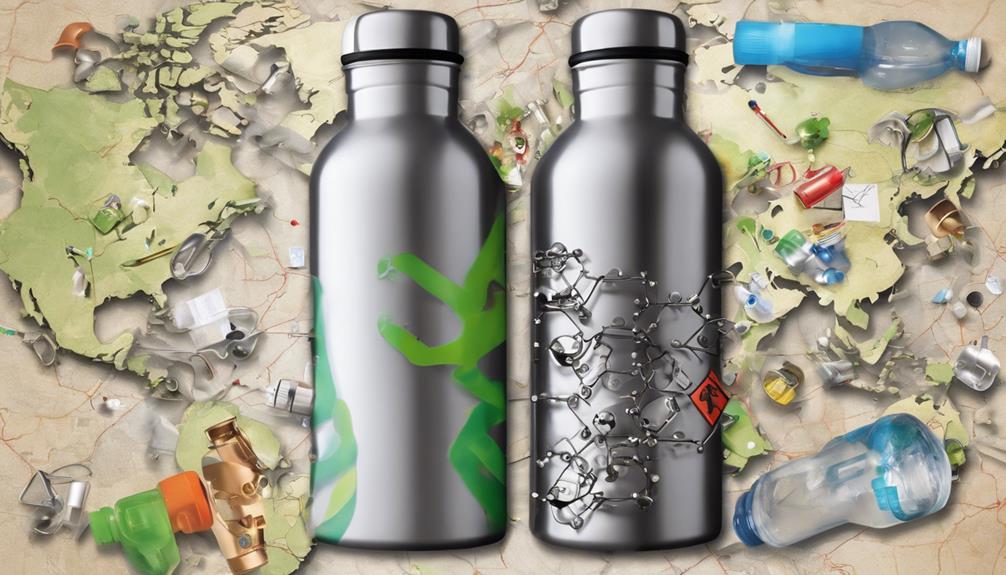
To locate recycling facilities near you, start by finding recycling centers in your area. Check local directories for information on drop-off locations or recycling programs.
Utilize online resources such as Earth911 or RecycleNow to easily identify nearby recycling facilities.
Find Recycling Centers
Locating recycling centers near you is crucial for properly disposing of stainless steel water bottles. Recycling benefits both the environment and conserves valuable resources.
Here are some tips to help you find recycling facilities in your area:
- Online Search: Use search engines or recycling locator websites to find nearby recycling centers. Websites like Earth911 or RecycleNation can assist in locating the closest facilities.
- Local Government Resources: Check your city or county's official website for information on recycling centers. Many local governments provide detailed guides on recycling options available in the area.
- Contact Recycling Companies: Reach out to local recycling companies or waste management services. They can provide information on drop-off locations or recycling programs they offer.
- Ask Local Businesses: Inquire at local supermarkets, hardware stores, or community centers. These establishments often have recycling programs or can direct you to nearby facilities.
Check Local Directories
How can you efficiently identify nearby recycling facilities to properly dispose of stainless steel water bottles?
Checking local directories is a practical way to locate recycling centers in your community. Local resources like city websites, phone books, or community newsletters often provide valuable information on recycling facilities near you.
By engaging with your community through local directories, you can easily find designated drop-off locations or recycling programs that accept stainless steel water bottles.
Community engagement plays a vital role in promoting sustainable practices like recycling. Through local directories, you can discover nearby recycling facilities that support environmental initiatives. Many municipalities have dedicated sections in their directories listing recycling centers, making it convenient for residents to access this information.
Utilize Online Resources
Online resources offer a convenient way to locate nearby recycling facilities for proper disposal of stainless steel water bottles. When looking to recycle your stainless steel water bottle, consider utilizing online resources to find the nearest recycling centers.
Here are a few tips to help you locate recycling facilities near you:
- Earth911: Visit Earth911's website and enter your location along with the item you wish to recycle. The site will provide you with a list of recycling centers that accept stainless steel water bottles.
- RecycleNation: This platform allows you to search for recycling facilities by entering your ZIP code. It provides information on various recycling options, including stainless steel water bottle recycling.
- Local Government Websites: Check your local government's website for information on recycling programs and facilities in your area.
- Recycling Apps: Consider downloading recycling apps like iRecycle or Recycle Coach, which can help you find recycling centers near you and promote sustainable practices.
Creative Ways to Repurpose Old Bottles
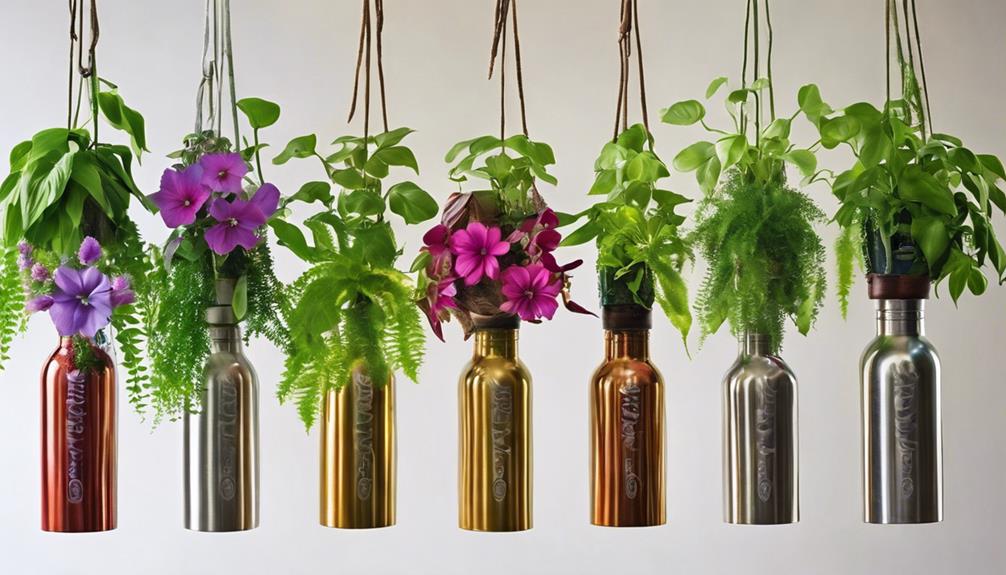
Consider exploring various DIY projects that can transform your old stainless steel water bottles into functional and stylish household items. Upcycling projects and donation programs offer a sustainable way to repurpose these bottles, giving them a new life beyond their original purpose. By engaging in DIY crafts and artistic designs, you can unleash your creativity while contributing to environmental conservation.
Here is a table showcasing some creative ways to repurpose old stainless steel water bottles:
| Repurposing Idea | Materials Needed | Instructions |
|---|---|---|
| Hanging Planters | Bottle, Rope, Soil, Plants | Cut bottle, Drill holes, Insert rope |
| Desk Organizer | Bottle, Paint, Scissors | Cut bottle, Decorate, Use compartments |
| Outdoor Lanterns | Bottle, Candle, Wire | Cut bottle, Insert candle, Hang with wire |
| Pencil Holder | Bottle, Washi tape | Decorate with tape, Use for pens/pencils |
These ideas not only help reduce waste but also add a personal touch to your living space. Let your imagination guide you in transforming old bottles into new and useful items.
Tips for Maintaining Your Bottle's Longevity
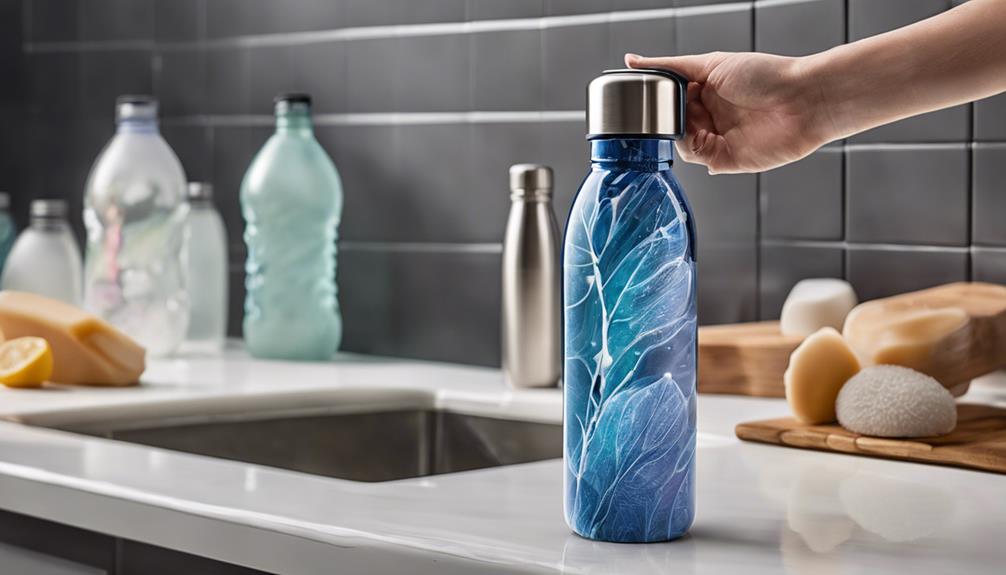
To prolong the lifespan of your stainless steel water bottle, regularly clean it with mild soap and water to prevent build-up and maintain its quality. Cleaning methods are crucial in maintaining the durability of your bottle.
Here are some tips to help you keep your bottle in top condition:
- Hand Wash Only: Avoid using harsh chemicals or abrasive materials that can damage the bottle's finish.
- Dry Thoroughly: After washing, ensure your bottle is completely dry to prevent any lingering moisture that could lead to rust.
- Avoid Extreme Temperatures: Stainless steel is known for its insulation benefits, but extreme temperatures can affect its performance over time.
- Check Travel-Friendly Features: If your bottle has additional components like straws or lids, make sure they're securely attached to prevent leaks and maintain the bottle's travel-friendly features.
Frequently Asked Questions
Can Stainless Steel Water Bottles Be Recycled With Other Metals?
When considering metal recycling, sustainability is crucial. Recycling stainless steel water bottles with other metals helps reduce environmental impact. Proper waste management ensures resources are conserved and less waste ends up in landfills.
Are There Any Limitations on the Number of Times Stainless Steel Bottles Can Be Recycled?
When it comes to stainless steel bottles, the recycling process has its limits. While they can be recycled multiple times, there are durability limitations. Consider the environmental impact and explore reuse options for sustainability.
Is It Safe to Recycle Stainless Steel Bottles if They Have Dents or Scratches?
If dents or scratches appear on stainless steel bottles, they may compromise rust prevention and aesthetic appeal. Although minor cosmetic damage may not affect recycling, ensure the integrity of the bottle is maintained for optimal reuse.
Can Stainless Steel Bottles With Plastic Components Be Recycled?
Yes, you can recycle stainless steel bottles with plastic components. The recycling process separates materials efficiently. Stainless steel is valuable in recycling due to its high scrap value. Plastic components are sorted and recycled separately.
What Should I Do if There Are Labels or Stickers on My Stainless Steel Bottle?
When labels or stickers are on your stainless steel bottle, removing them is vital. Use a gentle cleanser or rubbing alcohol to clean any residue left behind. Ensure the bottle is clean before recycling to avoid contamination.
Conclusion
In conclusion, recycling your stainless steel water bottle is a simple yet impactful way to reduce waste and protect the environment.
By understanding the recycling process, preparing your bottle properly, and locating recycling facilities near you, you can easily contribute to a more sustainable future.
Remember, small actions like recycling can have a big impact on the world around us. So, next time you finish your water, don't forget to recycle that bottle!

